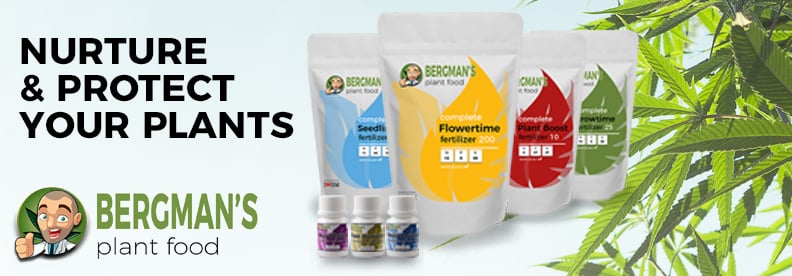The Complete Cannabis Nutrient Deficiencies Guide

Did you know that even if you follow feeding instructions to the letter, your plants might still suffer from nutrient deficiency? Therefore, it’s essential that all growers (including perfectionists) know when their plants are low on nutrients.
As time is of the essence here, it is crucial that you can spot these issues early on and act fast. This will allow you to give your plants what they need and ensure they can still deliver top-quality buds.
Fortunately, you can learn everything you need to know from this accessible and informative cannabis nutrient deficiencies guide! Read it to make sure you can keep your plants in tip-top shape by identifying and treating common nutrient issues.
Do your plants have a nutrient deficiency?
Before you start figuring out how to help your nutrient-deficient cannabis plants, you must ask an essential question - are my plants actually low on nutrients? There are a few signs that will give you a good indication as to whether your plants are getting the nutrients they need. These giveaways are relatively subtle so you need to know what to look out for. Fortunately, you can find all the info you need in this cannabis nutrient deficiencies guide.
Symptoms noticeable on cannabis leaves
If you're concerned about the health of your cannabis plants, one of the first things to check for is nutrient deficiencies. By looking closely at the fan leaves of your plants, you will be able to get a pretty good idea of what is going on.
Yellow Leaves and discoloration

Do some of your leaves look sad and yellow? Or does it look like the color has left some of them altogether (known as discoloration)? If so, then your plants are trying to tell you that they are dealing with one of the following challenges:
- Nutrient deficiencies: A lack of essential nutrients like nitrogen, phosphorus, or potassium can cause fan leaves to turn yellow. However, each nutrient will have slightly different symptoms. More on that later.
- Overwatering or underwatering: Excessive watering can deprive the plant roots of oxygen, while not enough water might lead to the leaves looking thin and droopy. In both situations, the leaves can become yellow as well.
- pH imbalance: An incorrect pH level in the growing medium can hinder nutrient uptake as the plant struggles to absorb the necessary nutrients, causing the leaves to turn yellow.
- Lighting issues: Insufficient light can lead to yellowing and drooping of the lower leaves in the plant.
- Temperature issues: Heat stress from temperatures above 28°C (80°F) can slow down photosynthesis and cause leaves to turn yellow. Similarly, cold shock from temperatures below the ideal range can also cause the plant to wither and turn yellow or purple.
- Pests: Yellowing leaves, accompanied by spots or signs of insect damage, could indicate a pest infestation.
Dark or brown leaves
Dark or brown leaves might suggest one of the following potential issues:
- Nutrient deficiencies or toxicities: Certain nutrient imbalances, such as magnesium or calcium deficiency, can cause dark or brown spots on the leaves. Interestingly, using too much of specific nutrients can also lead to darkened leaves.
- Heat stress: Too much light can burn the leaves and turn the leaves closest to the light source to yellow. When they are burned they will also curl up at the tips.
- Overwatering: Overwatering can negatively impact plants’ roots, which leads to the browning of leaves as the plant struggles with accessing enough oxygen.
- Disease or fungal infection: Certain diseases and fungal infections can cause browning of the leaves.
- Pests: Some pests, like spider mites or thrips, can cause damage to the plants and show browning or dark spots on the leaves.
In short, whenever your plants show changes in their leaves, they are sending you a message. It is your job to figure out what that message is and, most importantly, what you should do to help them.
The importance of pH levels
Understanding and managing pH levels is crucial for successful cannabis cultivation. pH is a measure of the acidity or alkalinity of a solution on a scale from 0 to 14, with 7 being neutral.
Cannabis enjoys more of an acidic environment, and the perfect pH for your plants will depend on the medium in which you grow.
If you are working with soil, the ideal pH range would be between 6.0 and 7.0, while for hydroponics, you should be looking for something between 5.5 and 6.5. Note that when it comes to hydroponics, your equipment should come with clear instructions on what pH level would be best.

Organic Growing and pH Levels
 For those growing cannabis organically, pH management may be less critical. When you grow purely organically—without administering mineral nutrients—pH becomes less of an issue. For example, if you're using amended or composted soil that is rich in organic matter, the microorganisms within the ground will help make nutrients more available to the roots. This helps reduce the need for strict pH monitoring. However, it's still essential to maintain a healthy soil environment to support the thriving microbial life that benefits your marijuana plants.
For those growing cannabis organically, pH management may be less critical. When you grow purely organically—without administering mineral nutrients—pH becomes less of an issue. For example, if you're using amended or composted soil that is rich in organic matter, the microorganisms within the ground will help make nutrients more available to the roots. This helps reduce the need for strict pH monitoring. However, it's still essential to maintain a healthy soil environment to support the thriving microbial life that benefits your marijuana plants.
Mobile and Immobile Nutrients
Nutrients can be classified into two categories: mobile and immobile.
Mobile nutrients, such as nitrogen, phosphorus, and potassium, can move within cannabis plants to areas where they're needed the most. In contrast, immobile nutrients, like calcium and iron, cannot easily move around within cannabis plants. Instead, immobile nutrients will remain close to where they have been allocated on the plants. So be aware of this fact and use fertilizers and spays with immobile nutrients on the affected area of your plants.
Symptoms of mobile nutrient deficiencies usually appear on the lower, older leaves first. This is because cannabis plants will transport mobile nutrients from older leaves to the newer growth when there's a shortage. Some common signs of mobile nutrient deficiencies include:
- Yellowing of older leaves
- Leaf tips and edges turning brown
- Leaves may fall off the plant
Symptoms of immobile nutrient deficiencies typically appear on the upper, newer leaves first. The plant cannot move these nutrients from older leaves to newer growth. Some common signs of immobile nutrient deficiencies include:
- Yellowing between the veins of new leaves
- Curling or twisting of new leaves
- Spots, stripes, or mottling on new leaves
We will go through all of them in this cannabis nutrient deficiencies guide.
Difference between Deficiencies and Toxicities (Excesses)
Even though most people worry about nutrient deficiency (lack of nutrients), there is also the possibility of causing nutrient toxicity. This happens when your plants get "too much of the good stuff" and, as a result, suffer from an excess of certain nutrients.
Common Cannabis Nutrient Deficiencies & Toxicities
If you suspect your plants are suffering from nutrient deficiencies or toxicities, the first step is figuring out which nutrient is the culprit. Let's explore some of the most common cannabis nutrient deficiencies and toxicities, along with their symptoms and treatment options.
Nitrogen
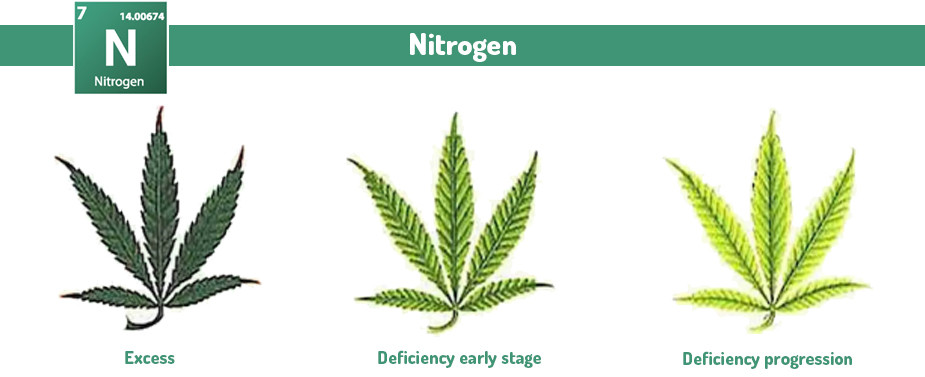
Nitrogen Deficiency Symptoms:
- The bottom leaves of the plant turn yellow
- The leaves lose their shiny appearance and look dull
- The yellowing starts at the bottom and moves up the plant
- The leaves turn yellow, curl, and may have spots on them
- The leaves start to fall off the plant
- The plant is shorter than normal and has smaller leaves
- The plant may start to flower too early and not produce as much fruit or flowers as usual
Nitrogen deficiency causes the older, lower leaves to turn yellow. It will usually start from the tips and move inward.
As the deficiency progresses, the yellowing of the leaves will move upwards, and some might even start to curl and, in the end, fall off. Your marijuana plants will end up flowering too early and producing a poor yield.
How to treat:
Start using fertilizers with high Nitrogen content and check the pH is good to ensure your plants can uptake the nutrients.
Also, consider using sprays to help the leaves absorb the necessary nutrients.
Nitrogen Toxicities (Excesses) Symptoms:
- The bottom leaves turn a very dark shade of green
- The green color moves up the plant from the bottom
- The foliage becomes weak and thin, and may not look as healthy as before
- The stems may become weak and may not be able to support the weight of the plant as well
- The system that transports water and nutrients through the plant may become weak, leading to slower growth
- The resulting harvest may taste "green" or unripe, as if it hasn't fully matured
How to treat:
Switch to a fertilizer with a lower nitrogen content for a while and flush the growing medium with water to help remove excess nutrients and salts.
Phosphorus
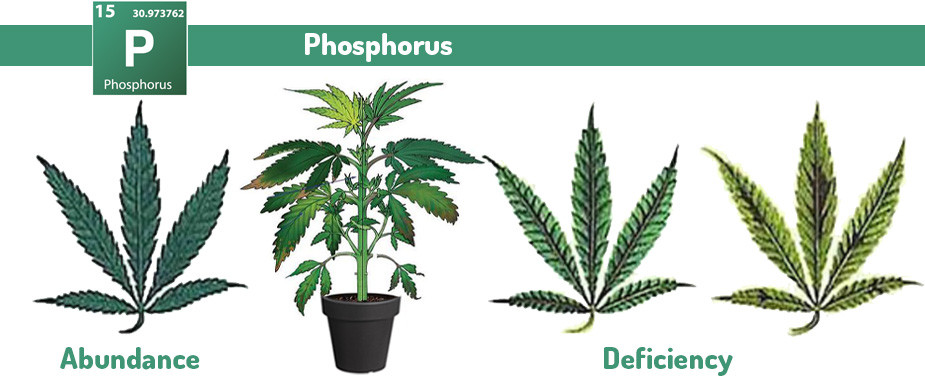
Phosphorus Deficiency Symptoms:
- The leaves may take on a bluish-green color
- The stems that attach the leaves to the plant (petioles) may turn a purplish color
- The plant's growth may slow down, both vertically and horizontally
- Lower leaves may develop dark, copper-colored or purple-to-blackish dead blotches
- Severely affected leaves may develop dark, bronzy, metallic purple color and may curl, contort, wither, and eventually drop off the plant
- A lack of phosphorus can weaken the plant and make it more susceptible to diseases and pests
The leaves will change color to dark green or blue/purple. This will be most noticeable in the veins and on the edges of the leaves, and the stems will look reddish/purple.
How to treat Phosphorus Deficiency:
When dealing with phosphorus deficiency, check your pH and make sure it is acidic. Also, make sure the roots are not overwatered and ensure adequate drainage. And make sure to use some phosphorus-rich fertilizer.
Phosphorus Toxicity Symptoms:
- The newer leaves may develop yellowing between their veins (interveinal chlorosis)
- The new leaves may be thinner than usual
- The tips and edges of the leaves may become burnt or brown
- There may be less space between the nodes on the stem
- Deficiencies in other micronutrients like zinc, calcium, magnesium, and iron may also appear
- The lower leaves may curl and develop spots
- The tips of the roots may start to die back
- The buds may taste "chemical" or not have the usual taste
Excess phosphorus can cause deficiencies in other nutrients, such as zinc and iron. Too much phosphorus can also slow down root growth and turn the ends of the roots black.
Lower leaves might also indicate toxicity if they develop spots.
How to treat Phosphorus Toxicity:
Use a fertilizer with a lower phosphorus content to prevent further buildup of the nutrient, and flush the growing medium with water to help remove excess nutrients and salts.
Potassium
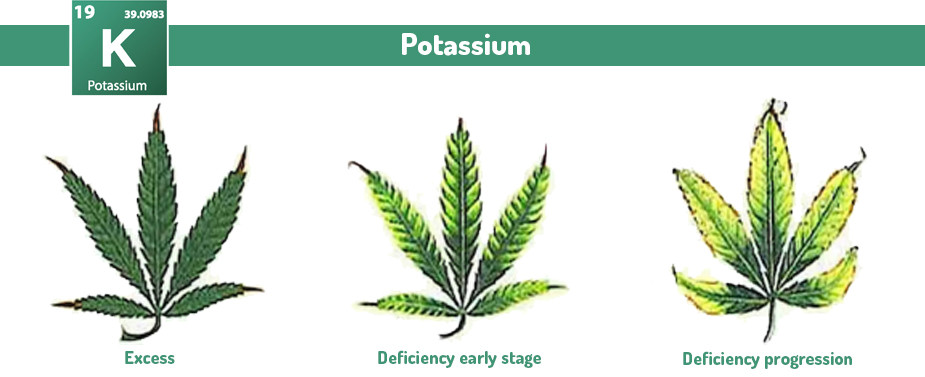
Potassium Deficiency Symptoms:
- The older leaves may turn pale and become yellowed between the veins (chlorosis)
- The edges and tips of the leaves may turn a rusty color and become burnt or brown
- The stems of the plant may become weak, scrawny, and even brittle in severe cases
- The plant may start to produce more side shoots or branches
- The plant may produce fewer or smaller buds
The first sign of potassium deficiency is usually a change of color in leaf edges from green to yellow. With time, they will curl inwards and eventually turn brown.
The plants will also show less resistance to diseases and pests, as a potassium deficiency will weaken their ability to defend themselves.
How to treat Potassium Deficiency:
Apply a fertilizer high in potassium into your medium or straight on the leaves. Check that you are not overwatering or underwatering your plants, as both can decrease the roots' ability to uptake potassium.
Potassium Toxicity Symptoms:
- An excess of potassium can lead to deficiencies in other important nutrients like calcium, magnesium, zinc, and iron
- The newer leaves may develop yellowing between the veins (interveinal chlorosis)
- The new leaves may be thinner than usual
- The tips and edges of the leaves may become burnt or brown
- There may be less space between the nodes on the stem
- The lower leaves may curl and develop spots
- The tips of the roots may start to die back
- The pH level of the soil in the root zone may become more acidic
The main symptom of potassium toxicity can be found in the new leaves, as they will have fragile blades and look burned on the edges.
How to treat Potassium Toxicity:
Use a fertilizer with less potassium and flush the growing medium with water to remove any excess.
Calcium
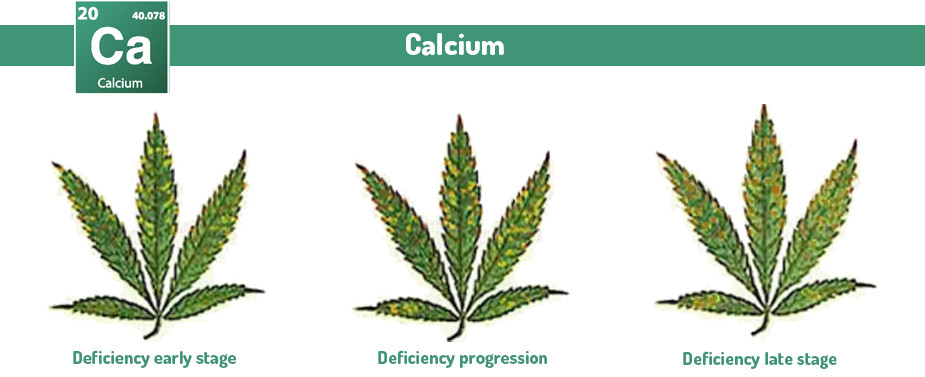
Calcium Deficiency Symptoms:
- The lower leaves may start to contort and curl
- Yellowish-brown irregular spots may appear on the leaves and along their edges
- The development of flowers may slow down
- The tips of the roots may start to die back
- The plant may be stunted in growth and produce a smaller harvest than expected
Calcium deficiency can impact the look of new leaves and make them curl or twist. A lack of calcium can also cause black spots to appear on both the leaves and stems, resulting in underdeveloped roots.
How to treat Calcium Deficiency:
Use one of the widely available calcium nutrient supplements.
Calcium Toxicity Symptoms:
Too much calcium can lead to deficiencies of other nutrients, causing leaf color to change. It can also negatively affect root growth and does so very quickly.
How to treat Calcium Toxicity:
- The leaves may start to wilt slightly
- The growth of the plant may be stunted
- An excess of calcium can block the uptake of other important nutrients like potassium, iron, magnesium, and manganese
Restore the nutrient balance by flushing the system and use a fertilizer with a lower calcium content to prevent further nutrient buildup
Magnesium
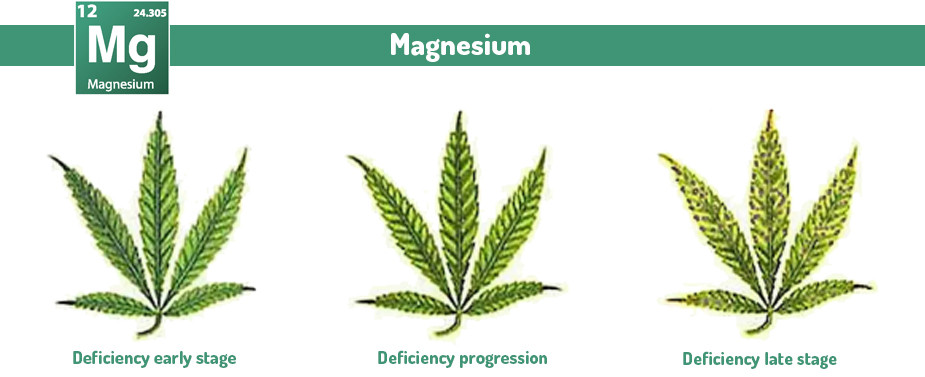
Magnesium Deficiency Symptoms:
- A magnesium deficiency may exist for 4-6 weeks before any outward signs become apparent
- The older and middle-aged leaves may develop yellowing between the veins (interveinal yellowing) and irregular rust-brown spots
- The plant may have an overall sickly appearance
- The older leaves may become dry, curl up, and drop off
This deficiency causes the areas between the leaf veins to turn yellow while keeping the veins, themselves, green. As the deficiency progresses, fan leaves may curl and develop brown spots.
How to treat Magnesium Deficiency:
Magnesium deficiency can be tricky to spot as it takes a few weeks before your plants start showing symptoms. When you notice them, you need to act very quickly. Check and adjust the pH levels (by flushing), use magnesium-rich fertilizers, and check your watering schedule, as inappropriate water levels might make it hard for roots to uptake magnesium.
Magnesium Toxicity Symptoms:
- The growth of the plant may become stunted
- Despite the excess of magnesium, the foliage may still appear dark green
- In some cases, the symptoms of a magnesium deficiency may appear similar to an overall salt toxicity
The main symptom is slowed growth, as high levels of magnesium make it hard for your plants to achieve their desired height.
How to treat Magnesium Toxicity:
Flush your medium with fresh water and use a fertilizer with a lower magnesium content to prevent further nutrient buildup. Also, make sure to monitor and maintain appropriate pH levels in the growing medium to ensure optimal nutrient absorption and avoid further nutrient imbalances.
Less Common Nutrient Deficiencies & Toxicities
While the macro-elements like nitrogen, phosphorus, and potassium are the most talked-about nutrients in cannabis cultivation, micro-elements and other less-common nutrients also play vital roles in plant health. While you need to use these in smaller quantities, their absence or excess can still cause problems. Here are some of them.
Iron
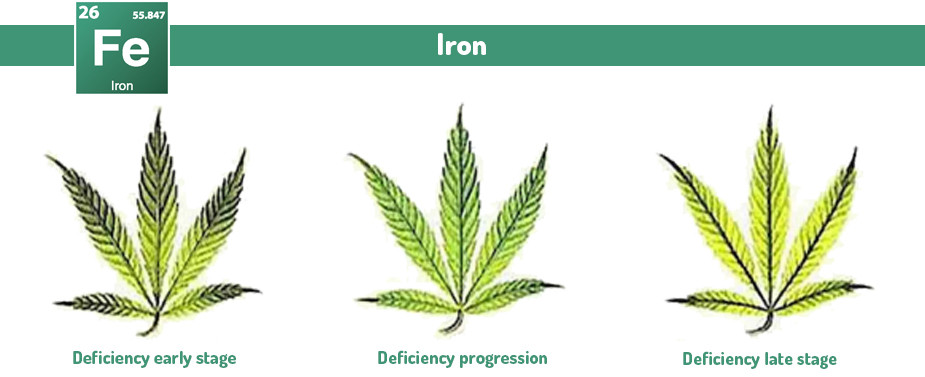
Deficiency Symptoms:
- The young leaves and shoots turn yellow between the veins, starting at the opposite end of the leaf tip
- As the deficiency becomes more severe, more and larger leaves turn yellow between the veins
- The leaves may start to die and fall off the plant
- The plant grows more slowly and produces less at harvest time. These symptoms may indicate a lack of iron
How to treat:
Use an iron chelate foliar spray or add iron-rich fertilizer to the growing medium.
Toxicities (Excesses) Symptoms:
- The leaves take on a bronze appearance and may have small dark-brown spots
- The plant may have difficulty taking up phosphorus, and this can result in signs of deficiency appearing in the lower leaves. These symptoms may indicate an excess of iron
How to treat:
Flush the growing medium with water to remove excess iron and adjust the fertilizer ratios.
Manganese

Deficiency Symptoms:
- The young leaves show yellowing between the veins first, indicating a lack of manganese
- Severely affected leaves may develop pale, dead spots that eventually fall off the plant
- A telltale sign of a manganese deficiency is that the margins of the leaves remain dark green while the areas between the veins turn yellow
- As the deficiency progresses, the symptoms spread from the younger leaves to the older leaves
How to treat:
Use manganese foliar spray or add manganese-rich fertilizer to the growing medium.
Toxicities (Excesses) Symptoms:
- The young and new growth on the plant develops yellowing with dark orange to dark rusty brown mottling on the leaves, indicating an excess of manganese
- The tissue damage caused by excess manganese initially shows up on the younger leaves before progressing to the older leaves
How to treat:
Flush the growing medium and readjust the fertilizer ratios.
Zinc
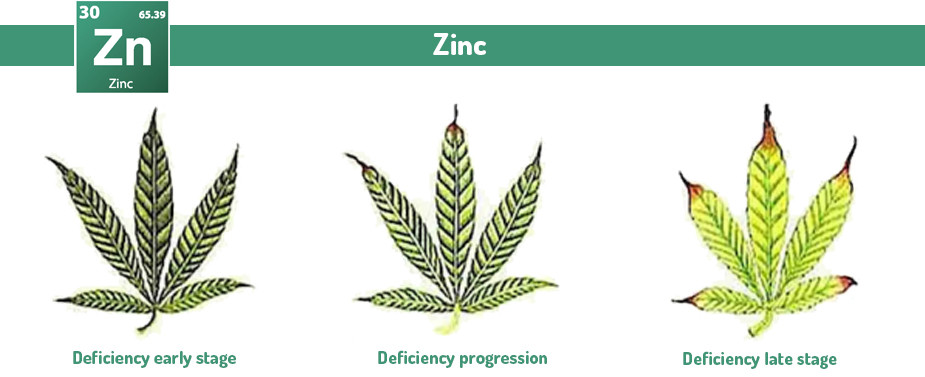
Deficiency Symptoms:
- The new and young leaves of the plant exhibit yellowing between the veins, which is known as interveinal chlorosis. They may also develop small, thin blades that contort and wrinkle
- The stem tips of the plant often fail to elongate, and growing shoots/tips become "bunched up
- The leaf tips, and later the margins, may discolor and burn due to a lack of zinc
- Zinc deficiency can also reduce internode spacing, stunt new growth (including buds), and severely diminish yield
Zinc deficiency can cause leaf curling and reduced leaf size. This is especially noticeable in young leaves. At a later stage, you might notice your leaves looking burnt with discolored tips.
How to treat:
Consider using zinc-rich foliar spray or fertilizer.
Toxicities (Excesses) Symptoms:
- Zinc overload is extremely rare but can be severely toxic to plants, causing them to die quickly
- An excess of zinc can interfere with iron's ability to function properly, leading to an iron deficiency
Zinc toxicity can result in root damage, reduced nutrient uptake, and overall plant stress.
How to treat:
Flush the growing medium with water and adjust the fertilizer ratios to bring the balance back.
Sulfur
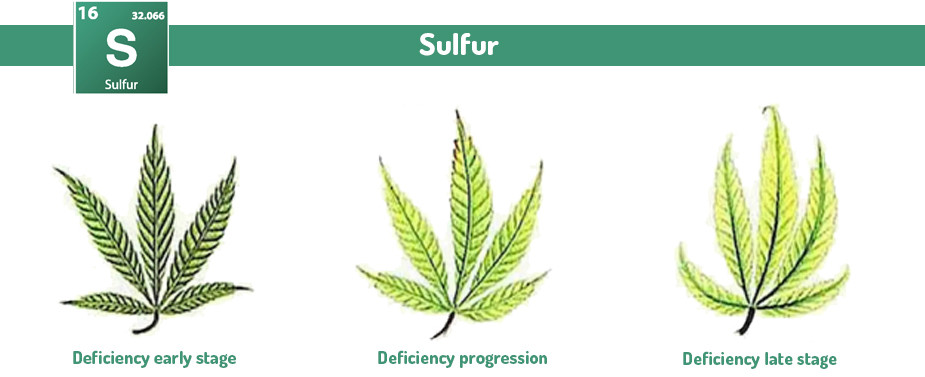
Deficiency Symptoms:
- Young leaves turn light green to yellowish, and their growth is slowed down
- As the sulfur shortage continues, the leaf veins start to turn yellow and the leaves become less juicy
- The tips of the leaves may become burnt, darkened, and curled downwards
- When sulfur deficiency is combined with an overall nutrient deficiency, long purple streaks might appear along the length of the stem
- The stems may also become woody
- Bud formation becomes weak and slow
Sulfur deficiency can cause young leaves to turn yellow or pale green and older leaves to develop reddish or purple tints. Buds also tend to grow very slowly, which is something you definitely don’t want.
How to treat:
Sulfur deficiency is uncommon, but if it happens make sure to incorporate a sulfur-rich fertilizer or foliar spray containing sulfur.
Toxicities (Excesses) Symptoms:
- The plant's growth is stunted and smaller than usual
- The leaves are uniformly smaller and appear dark green in color.
- When the excess is severe, the leaf tips and margins may discolor and burn
Sulfur toxicity is rare, but when it does occur it can cause the fan leaves to turn yellow and curl.
How to treat:
Flush the growing medium with water and change the fertilizer.
Copper

Deficiency Symptoms:
- The young leaves and shoots of the plant may wilt, contort, and die back due to a lack of copper
- The leaf tips and margins of the plant may turn dark-green to copper-gray and die back
- The growth of the plant is slow and the yield decreases due to the copper deficiency
Copper deficiency can cause young leaves to become curled and slightly pale. On top of that, the tips of all your leaves can turn dark green or black.
How to treat:
Include more copper-rich fertilizer into the growing medium.
Toxicities (Excesses) Symptoms:
- The plant experiences slower overall growth when there is an excess of copper
- Interveinal iron chlorosis can occur due to an excess of copper
- The plant may grow fewer branches than usual
- The roots of the plant may start to decay or become thick and slow-growing due to an excess of copper
Copper toxicity can lead to stunted growth and fewer new branches appearing.
How to treat:
Flush your growing medium with water and consider changing fertilizer to one with less amounts of copper.
Boron

Deficiency Symptoms:
- Abnormal growth of stems, tips and roots
- Shoots appear burned and may contort
- Development of necrotic spots between leaf veins
- Development of rust-colored, corky stems
- Leaves thicken and become brittle
- Root tips often swell, discolor and stop elongating
Boron deficiency can make your plants look like they are dying off. The tips of the leaves might also change shape.
How to treat:
Invest in a good boron-rich fertilizer for the growing medium.
Toxicities (Excesses) Symptoms:
- Leaf tips turn yellow before appearing burned
- Leaves become yellow and fall off
Boron toxicity may cause the fan leaves to turn yellow, curl, and drop.
How to treat:
Once again, flush and adjust the fertilizer ratios.
Molybdenum

Deficiency Symptoms:
- Leaves may drop prematurely
- Leaves can become distorted, and the edges may dry out
- In colder weather, the older and middle leaves may turn yellow, and there may be interveinal chlorosis, which means the veins remain green while the area between them turns yellow
Molybdenum deficiency can make the leaves turn yellow, with the edges curling upward and inward.
How to treat:
Use a fertilizer that contains molybdenum.
Toxicities (Excesses) Symptoms:
- Leaves appear scorched or burnt at the edges
- Leaves may curl or roll up
- Dark green leaves with a metallic sheen
- Reduced growth or stunted growth
- Interference with the uptake of other nutrients
How to treat:
Flush the growing medium with water and adjust the fertilizer you are using.
Nutrient Lockout
Nutrient lockout is an issue that every cannabis grower needs to be aware of. It happens when your plants can not use the nutrients they desperately want and need,even if they have access to them.
What is it?
There are many reasons why cannabis plants might not be able to absorb what they need from the growing medium. A nutrient lockout can result from imbalanced pH levels, salt buildup, or other factors. When lockout happens, the marijuana plants are unable to absorb essential nutrients and end up with deficiencies and very poor health (even when properly fed).
How to spot this
If you know that you are providing your plants with the right amount of various nutrients but start noticing signs of deficiencies, you are most likely dealing with nutrient lockout.
How to treat this
To treat nutrient lockout, first determine the cause. Check the pH levels in your growing medium and adjust if necessary. If salt buildup is the issue, flush the growing medium with water to remove excess salts. Sometimes, you might need to switch to a different nutrient mix to suit the needs of your plants better. Remember to monitor your grow closely for signs of improvement and adjust the feed as needed.
Mulder's Chart
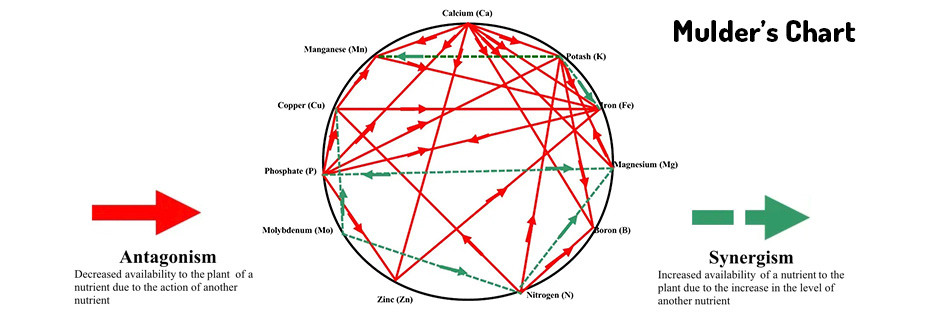
Mulder's Chart is relevant to nutrient lockout because it emphasizes the importance of providing plants with all essential nutrients in adequate amounts. If one nutrient is limited or unavailable, it can create a bottleneck that limits the plant's ability to use other nutrients. To ensure maximum growth and health of plants, it's crucial to provide them with all the essential nutrients to avoid lockout.
According to Mulder's diagram, excessive levels of nitrogen may have varying effects on the assimilation of other essential nutrients. Although nitrogen can encourage the absorption of magnesium and molybdenum, it may have the opposite effect on boron, copper, and potassium uptake in plants.
Other Cannabis Problems
In addition to nutrient deficiencies and toxicities, cannabis plants face various challenges. Let's take a look at some common problems not related to nutrition and learn how to prevent and address them.
Bud Rot
Bud rot, also known as gray mold, is a fungal infection that can devastate the most thriving cannabis plants.
It occurs when mold spores infiltrate the plant's buds and break down the plant tissue, causing decay and rot. The affected buds may turn brown, gray, or black, creating a musty, unpleasant smell.
How to prevent it:
Regarding bud rot, it's all about humidity and air circulation. Ensure your grow space has the proper humidity levels, excellent air circulation, and enough breathing space between the plants. Get into a habit of regularly inspecting your plants for signs of mold, and if you suspect any buds of being affected, remove them immediately to prevent any spreading.
How to solve it:
Remove the affected buds and nearby leaves if you discover bud rot on your plants. First, dispose of them, then focus on improving the growing environment by increasing air circulation, reducing humidity, and applying a fungicide to help prevent further infection.
Bug Problems
Pests can cause significant damage to cannabis plants, and to stand any chance, you need to make sure you detect their presence early on.
Dealing with bug problems in cannabis plants requires vigilance and a proactive approach.
To protect your plants from common pests such as spider mites, aphids, whiteflies, and thrips, you will need to do a few things:
- Maintain a clean growing environment to prevent pests from thriving.
- Regularly inspect your plants to catch any infestations early on.
- If you find pests, consider introducing beneficial insects or natural predators.
- Act quickly upon discovering an infestation.
Last but not least, if you're working with clones, ensure you only get them from trusted breeders. Otherwise, you might accidentally bring home more than just clones.
Conclusion
We've covered a lot of ground, haven't we? From reading cannabis leaves like a fortune teller to diving into the world of pH levels and nutrients, we've learned the ins and outs of keeping cannabis plants happy and healthy. We've also discovered the difference between deficiencies and toxicities, explored the issue of nutrient lockout, and even talked about pesky pests and dreaded bud rot.
In conclusion, it’s important to remember that knowledge is power when growing cannabis. So, keep an eye on your plants, adjust their environment as needed, and don't be afraid to ask for help if you're unsure. With a bit of practice and much love, you'll grow top-notch cannabis in no time. So, grab your gardening gloves, and let's get growing!
Stan
The effectiveness of THC Oil reintroduced me to the world marijuana. It’s amazing how this plant allows you to take the matters into your own hands. Growing this powerful plant at home truly gives me a self-supporting feeling. I even developed a green thumb.






